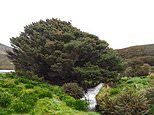
Revealed: The world’s loneliest tree, which sits on a remote New Zealand island 137 miles away from its nearest companionIt’s a 100-year-old pine on Campbell Island, 500 miles from New Zealand Why it has not managed to reproduce is something of a mystery Instead of growing in a conventional cone shape, it resembles a cauliflower
This tree looks unremarkable – but is, in fact, a record holder.
It’s a 30ft-tall 100-year-old pine – a Sitka spruce – on Campbell Island, 500 miles from New Zealand’s South Island, and has been recognised as the world’s most remote tree by Guinness World Records.
Its nearest companion is found 137 miles away on the Auckland Islands.
Would you be-leaf it? The world’s most remote tree – a Sitka spruce on Campbell Island. It is 137 miles away from any other tree
As any self-respecting arboriculturist will know, Sitka spruces have no business being on Campbell Island, or indeed anywhere in the Southern Hemisphere, as they’re native to the North American Pacific Coast (where they can grow to 300ft).
How this one arrived has a slight air of mystery about it.
It was originally thought to have been planted in 1901 by Lord Ranfurly, the governor of New Zealand, while he was on an expedition to collect bird specimens for the British Museum.
It was reported that he planted the conifer in the hope of transforming the island into a place of ‘productive forestry’.
However, in 2017 scientists said that, given the tree’s fast growth rate, it was likely to have been planted later, possibly post-1910.
Instead of growing in a conventional cone shape, the conifer resembles a cauliflower
The next slight mystery is why it’s not managed to spread seeds – via cones – and reproduce.
The consensus on this matter seems to be that the hacking of its central trunk by meteorological staff stationed on the island to make a Christmas tree, as Atlas Obscura reported – and the harsh sub-Antarctic weather – has left the tree in a permanently juvenile state.
These two factors, it’s thought, have also prevented the tree growing in a conventional cone shape. Instead, it resembles a cauliflower.
A map showing the location of remote Campbell Island, which is 500 miles away from New Zealand’s South Island
In 2018, the tree was used by scientists to determine that the world entered a new geological epoch known as the Anthropocene in 1965.
The Anthropocene is a term used to indicate when humans began to have a significant impact on the planet.
The researchers were able to mark this new epoch because they found a spike of radiocarbon in its wood as a result of above-ground nuclear bomb tests, according to University College London.
This spruce claimed the crown of loneliest in the world in 1973.
Until then, the title belonged to the last tree of Ténéré in the wastelands of Niger.
The effects of desertification left the acacia the only tree for 250 miles.
However, it was reportedly destroyed when a drunk driver crashed his vehicle straight into it.
The remains are now housed in the National Museum of Niger.
Advertisement
Share or comment on this article:
Source link
CHECK OUT: Top Travel Destinations
READ MORE: Travel News



